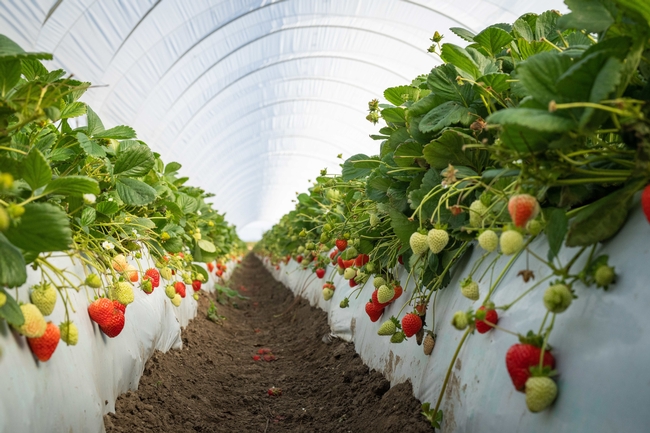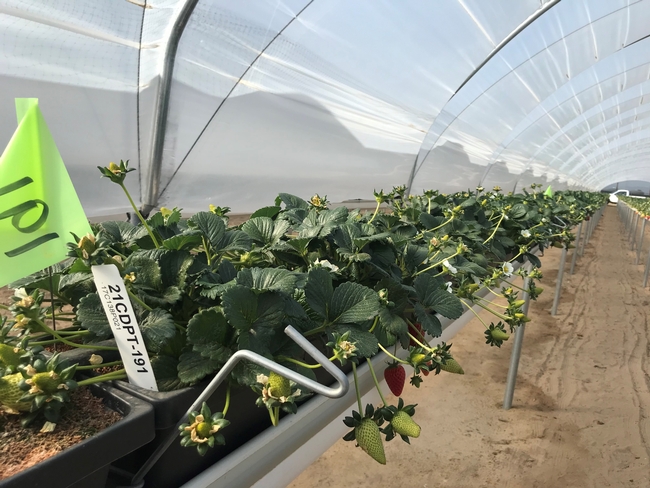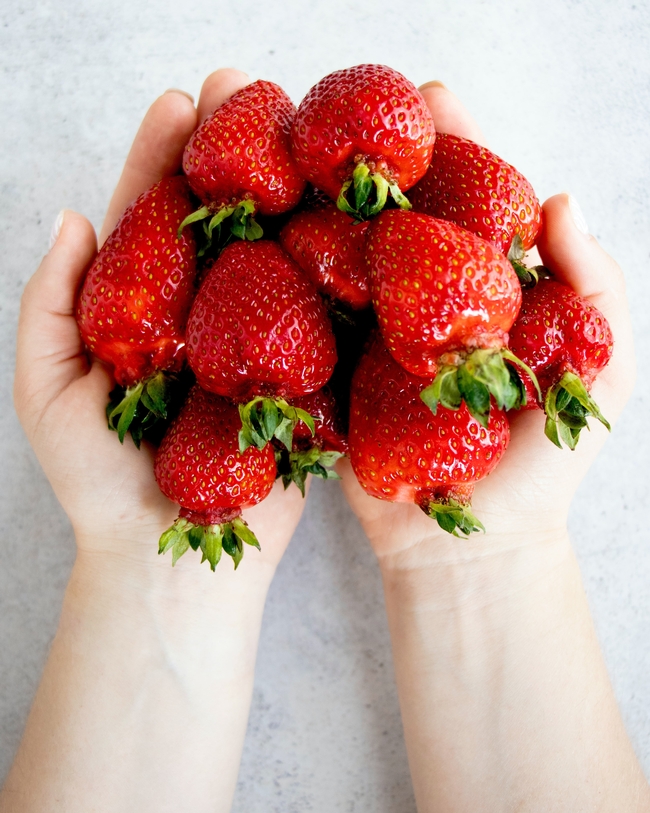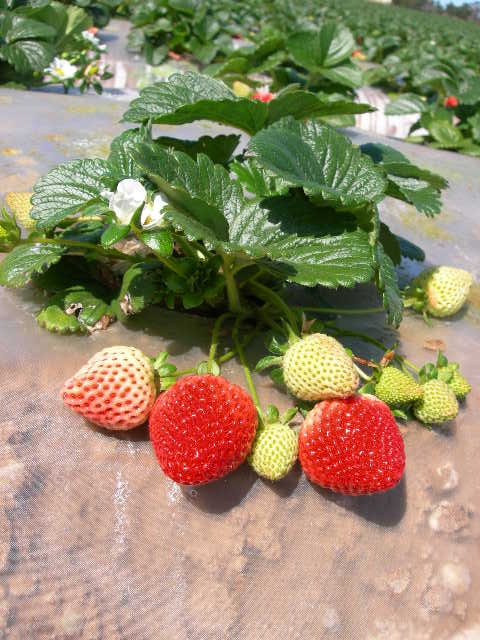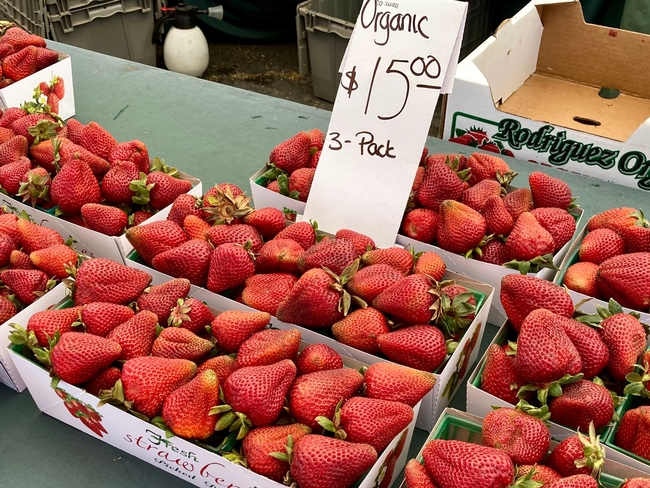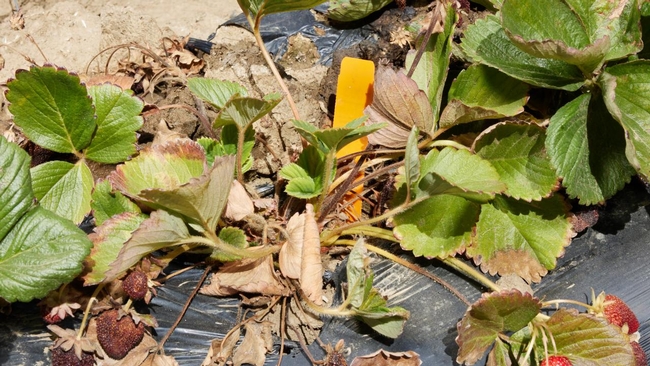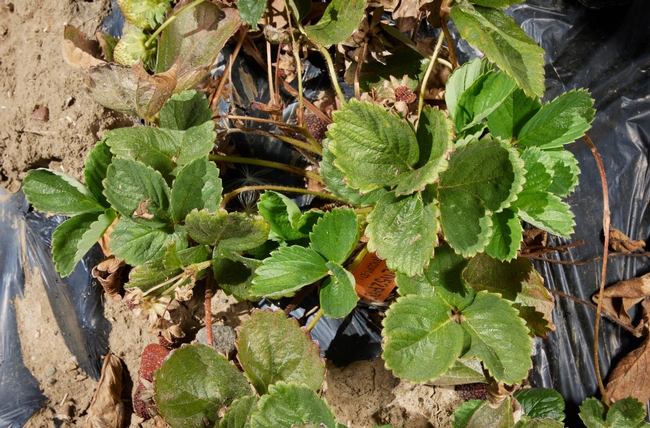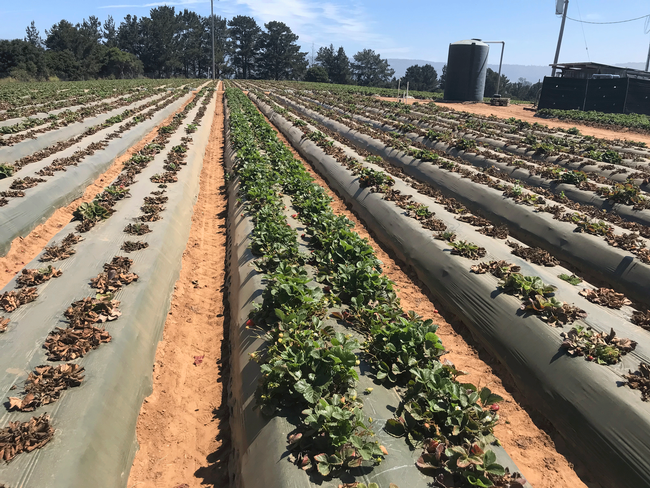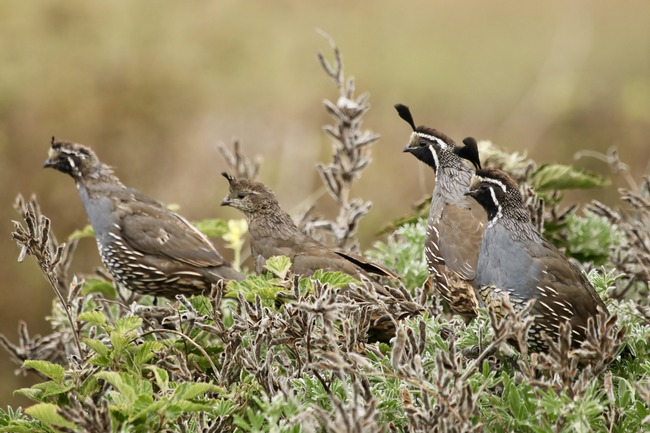Posts Tagged: strawberries
UC Davis releases 5 strawberry varieties resistant to deadly fungal disease
Strawberries selectively bred for Fusarium wilt resistance and high yields
The University of California, Davis, is releasing five new strawberry varieties that are resistant to the soilborne disease Fusarium wilt, have high yields and improved fruit quality.
UC Eclipse, UC Golden Gate, UC Keystone, UC Monarch and UC Surfline will be available for sale to California nurseries from Foundation Plant Services in April.
Roughly 88% of strawberries grown in the nation come from California. Fusarium wilt is one of the most common reasons for crop loss and death and yet 55 to 59% of cultivars planted in the state since 2014 have not been resistant, according to UC Davis research.
This is the first release from the UC Davis Strawberry Breeding Program where all the cultivars have Fusarium wilt resistance. They are meant to replace susceptible plants on the market such as Monterey, UCD Royal Royce and UCD Valiant.
Monarch was also developed specifically as a prototype for mechanical harvesting – another first out of the breeding program, which dates to the 1930s and has released 72 patented cultivars over the decades.
“These provide the same yield or better and they are Fusarium resistant,” said Steve Knapp, a Distinguished Professor in the Department of Plant Sciences and director of the UC Davis Strawberry Breeding Program. “They have a better collection of traits. They're superior.”
Knapp is a faculty member based in the College of Agricultural and Environmental Sciences at UC Davis and shares the UC Agriculture and Natural Resources land-grant mission of the Agricultural Experiment Station.
Dangerous pathogen
Fusarium wilt didn't present much of a danger to strawberry crops until after the fumigant methyl bromide was phased out of use in the United States in 2005. But the pathogen had always been in the soil, and cases of wilt appeared a year later and increased over time, leading to concerns that a Fusarium wilt pandemic could destroy the crop in California.
“The disease has taken off fast and we need to react quickly to address the need,” said Glenn Cole, a breeder and field manager with the Strawberry Breeding Program.
Knapp said the program tries to “encourage people to consider things like disease resistance” and routinely invites growers and other experts to events showcasing research breakthroughs and improved cultivars.
Varieties for the seasons
The new strawberry varieties each have improved flavor and characteristics that allow for near year-round growing around California, where about 1.8 billion pounds of the fruit are harvested each year. Some of the cultivars are adapted for production in the southern part of the state while others do well under the long daylight hours of summer along the coast.
Eclipse, a “summer plant” cultivar, has the potential to increase grower profitability as it produces in the fall and winter, and yields during research testing were 54% higher than similar cultivars. “We expect this cultivar to have wide commercial appeal,” Knapp said. “Eclipse is going to eclipse them all.”
Golden Gate and Keystone are “day neutral.” Those type of cultivars grow throughout the summer on about 60 percent of strawberry farming acres in the state. The “short-day” plants Surfline and Monarch are resistant to Verticillium wilt and Phytophthora crown rot.
Surfline and Eclipse are firmer and promise longer shelf lives. Monarch provides growers with improved fruit qualities relative to other mass-producedcultivars and has characteristics needed for advances in mechanical harvesting, Knapp said.
Genetic tools
Breeding program experts have long been researching ways to improve strawberry cultivars so the crop can withstand pests, disease and other stressors. To find plants that had Fusarium wilt resistance, they obtained the DNA of thousands of plants in field studies. The scientists also developed genetic tools to screen the plants and identify the genes that have resistance to the Fusarium pathogen.
Knowing that information allowed the team to breed resistance into and develop new cultivars, at a faster rate than previous efforts. “These tools have allowed us to sweep out the susceptibility and bring in resistance,” Knapp said.
UC Davis awarded grant to advance strawberry breeding, genetic tools
The $6.2 million grant centers on protecting crops in the future
The federal government is awarding $6.2 million to University of California, Davis, to study how to use breeding and genetic information to protect strawberry crops from future diseases and pests.
The four-year grant from the National Institute of Food and Agriculture (NIFA) centers on addressing expanding and emerging threats to strawberries, a popular fruit packed with Vitamin C and key to the diets of many Americans.
Enhanced plant breeding, gene editing and other technologies will be key to ensuring strawberry crops are sustainable in the face of climate change and possible restrictions on chemical use, said Steve Knapp, director of the Strawberry Breeding Center and a distinguished professor in the Department of Plant Sciences.
“We need to have the technology so that we can deal with the challenges strawberries face around the world,” Knapp said. “Can we use genetic knowledge to change the DNA in a specific way to get the resistance we need?”
USDA funding
The grant award was one of 25 announced Oct. 5 by NIFA – an agency of the U.S. Department of Agriculture – as part of the Specialty Crop Research Initiative program, which addresses “key challenges of national, regional and multistate importance in sustaining all components of food and agriculture…,” the agency said.
The strawberry industry has lagged behind crops like tomato and wheat when it comes to genetic and technical innovation, Knapp said, and the grant signifies that “now they want the foot on the accelerator.”
A key priority is identifying whether changing DNA molecules can improve disease resistance and what technologies would be needed. Ensuring some genes are expressed while others are suppressed would be part of the analysis.
“We're trying to build in natural resistance to pathogens through the genes that already exist but could be modified with this knowledge,” Knapp said. “If we were able to edit a gene that improves disease resistance, people would want us to use that in breeding.”
The intent is to produce disease-resistant cultivars and identify better ways to diagnose, prevent and manage disease. The research project will also include an economic forecast evaluating the consequences of production changes and communicating with farmers about the laboratory advances, according to the grant proposal.
Gitta Coaker from plant pathology and Mitchell Feldmann, Marta Bjornson and Juan Debernardi from plant sciences are participating in the research, as are scientists from California Polytechnic State University, UC Agriculture and Natural Resources, UC Berkeley, University of Florida and USDA's Agricultural Research Service.
UC study breaks down costs of growing organic strawberries
Thinking about commercially growing organic strawberries on the Central Coast?
To help prospective and current growers evaluate financial feasibility, the University of California has estimated costs to produce and harvest organic strawberries for fresh market in Santa Cruz, San Benito and Monterey counties.
“This revise of the last cost-of-production study incorporates the newest in labor costs along with updates on cultural techniques,” said study co-author Mark Bolda, UC Cooperative Extension strawberries and caneberries advisor in Santa Cruz, San Benito and Monterey counties.
The new study, “Sample Costs to Produce and Harvest Organic Strawberries in the Central Coast Region-2022,” has been released by UC Agriculture and Natural Resources and UC Davis Department of Agricultural and Resource Economics.
The analysis is based on a hypothetical well-managed organic strawberry farm using practices common to the region, but the costs, materials and practices shown in this study will not apply to all farms. Growers, UC Cooperative Extension farm advisors and specialists, pest control advisers and others provided input and reviewed the methods and findings of the study.
“Current growers can use it as a baseline to compare with their own cost and returns estimates to make sure they have an accurate picture of the profitability of their organic strawberry enterprise,” said co-author Brittney Goodrich, UC Cooperative Extension agricultural economics specialist. “Many agricultural lenders use these studies as a baseline to determine whether to approve operating or investment loan requests from current and potential strawberry growers.”
The researchers assume a farm operation size of 30 contiguous acres of rented land, with strawberries are planted on 27 acres. The study includes a list of suitable strawberry varieties for the region, but no specific variety is used in the study. The crop is harvested by hand and packed into trays containing eight 1-pound clamshells from April through early October, with peak harvest in June through August.
The authors describe the assumptions used to identify current costs for production material inputs and cash and non-cash overhead. Ranging analysis tables show net profits over a range of prices and yields. Other tables show the monthly cash costs, the costs and returns per acre, hourly equipment costs, and the whole farm annual equipment, investment and business overhead costs.
The study's expanded section on labor includes information on California's new minimum wage and overtime laws.
“It's reached a wider audience this time through presentations of the material to students at Cal Poly [San Luis Obispo] and also a group of USDA officials at the California Strawberry Commission,” said Bolda.
“All of this just underlines the value of these studies to California growers and others working in agriculture,” Bolda said.
Free copies of this study and other sample cost of production studies for many commodities are available. To download the cost studies, visit the UC Davis Department of Agricultural and Resource Economics website at https://coststudies.ucdavis.edu.
This cost and returns study was funded by the UC Davis Department of Agricultural and Resource Economics.
For additional information or an explanation of the calculations used in the studies, contact Jeremy Murdock, UC Davis Department of Agricultural and Resource Economics, at jmmurdock@ucdavis.edu or UC Cooperative Extension's Bolda at (831) 763-8025.
Researchers identify genes making strawberries resistant to Fusarium wilt
Resistant varieties to be released later this year to growers
Strawberry losses from Fusarium wilt could become less of a threat after researchers at the University of California, Davis, discovered genes that are resistant to the deadly soilborne disease.
The findings, published in the journal Theoretical and Applied Genetics, are the culmination of several years' work, and the discovery will help protect against disease losses, said Steve Knapp, director of the Strawberry Breeding Program at the college.
“What we've accomplished here is important and it's valuable for the industry and it's going to protect growers,” Knapp said.
Strawberries are a key crop in California, where about 1.8 billion pounds of the nutritious fruit are grown each year, making up roughly 88% of what is harvested in the United States.
Finding the genes could prevent a Fusarium wilt pandemic.
“The disease has started to appear more often up and down the state,” said Glenn Cole, a breeder and field manager with the Strawberry Breeding Program. “Once the wilt gets in, the plant just crashes. You have total die out.”
Searching for resistance
UC Davis scientists screened thousands of strawberry plants in the college nursery and took DNA samples. They then used genetic screening and developed DNA diagnostics to identify genes that are resistant to the primary race of Fusarium wilt.
“The genes have been floating around in the strawberry germplasm for thousands of years,” Cole said, but no one worked to identify them.
This latest development brings “strawberry into the 21st century in terms of solving this problem,” Knapp said.
Protecting future crops
This work means breeders can introduce the resistant gene into future strawberry varieties. This fall the program will release new cultivars that have the Fusarium wilt resistance gene. And the DNA diagnostic tools will help breeders respond to new Fusarium wilt variants that develop.
“There will be new threats and we want to be prepared for them,” Knapp said. “We want to understand how this works in strawberries so that as new threats emerge, we can address them as rapidly as possible.”
“If you don't have fusarium resistance, you're done,” Cole said. “The disease could be around more than you think.”
Fusarium wilt hasn't traditionally been an issue but when the fumigant methyl bromide was phased out in 2005, things changed. The disease was in the soil and without the fumigant, instances of wilt increased, especially in areas where crops weren't rotated.
Breeding new varieties
Knapp and Cole have informed the industry about current strawberry varieties that have the resistance so they can select plants with that added protection. The new resistant varieties coming out later this year will be suitable for several growing seasons.
“It's a big deal,” Cole said. “Everything is incremental in plant breeding, but it's a big deal.”
Plant scientists have been breeding strawberries at UC Davis since the 1930s and they have released more than 60 patented varieties through the public breeding program.
All of the work happened at UC Davis. Dominique Pincot, Mitchell Feldmann, Mishi Vachev, Marta Bjornson, Alan Rodriguez, Randi Famula and Gitta Coaker from the Department of Plant Sciences, and Thomas Gordon from the Department of Plant Pathology contributed to the research, as did Michael Hardigan and Peter Henry who are now at the U.S. Department of Agriculture Agricultural Research Service and Nicholas Cobo who is at University of La Frontera in Chile.
The research was funded by UC Davis and grants from the USDA National Institute of Food and Agriculture Specialty Crop Research Initiative.
Bringing out the best in wild birds on farms
Natural habitat maximizes the benefits of birds for farmers, food safety and conservation
A supportive environment can bring out the best in an individual — even for a bird.
After an E.coli outbreak in 2006 devastated the spinach industry, farmers were pressured to remove natural habitat to keep wildlife — and the foodborne pathogens they can sometimes carry — from visiting crops. A study published today from the University of California, Davis, shows that farms with surrounding natural habitat experience the most benefits from birds, including less crop damage and lower food-safety risks.
The study, published in the Journal of Applied Ecology, was conducted at 21 strawberry fields along California's Central Coast. It found that birds were more likely to carry pathogens and eat berries without surrounding natural habitat.
The authors said a better understanding of the interplay of farming practices, the landscape, and the roles birds play in ecosystems can help growers make the most out of wild birds near their fields.
“Bird communities respond to changes in the landscape,” said lead author Elissa Olimpi, a postdoctoral scholar in the UC Davis Department of Wildlife, Fish and Conservation Biology at the time of the study. “As birds shift in response to management, so do the costs and benefits they provide.”
The single most important driver
The study looked at how different farming practices influenced the costs and benefits that wild birds provided on the strawberry farms. The scientists combined nearly 300 bird surveys and the molecular analyses of more than 1,000 fecal samples from 55 bird species to determine which birds ate pests, beneficial insects and crops, and carried foodborne pathogens.
They also ranked birds to see which were more likely to bring benefits or costs to farmlands. Barn swallows, for instance, got a “gold star” in the study, Olimpi said. Their mud nests are commonly seen clinging to the underside of barn eaves, from which they fly out to swoop over fields, foraging on insects.
But rather than resulting in a list of “good” and “bad” birds, the study found that most bird species brought both costs and benefits to farms, depending on how the landscape was managed.
The presence of natural habitat was the single most important driver differentiating a farm where wild birds brought more benefits than harm.
“Nature is messy, and birds are complex,” Olimpi said. “The best we can do is understand how to take advantage of the benefits while reducing the harms. Growers will tell you it's impossible to keep birds off your farm — you can't do that and don't want to from a conservation perspective. So how can we take advantage of the services birds provide?”
Win-wins for birds and farms
The study is one of several publications from UC Davis Professor Daniel Karp's lab highlighting the environmental, agricultural, and food safety impacts of conserving bird habitat around farms. A related study in 2020 found that farms with natural habitat attracted more insect-eating birds — and fewer strawberry-eating birds — so that farmers experience less berry damage on farms with more habitat nearby. Such habitats also bring greater numbers of bird species to the landscape.
“All together, these studies suggest that farming landscapes with natural habitat tend to be good for conservation, farmers, and public health,” said Karp.
Additional co-authors of this study include Karina Garcia and David Gonthier of University of Kentucky, Claire Kremen of UC Berkeley and the University of British Columbia, William E. Snyder of University of Georgia, and Erin Wilson-Rankin of UC Riverside.
The research was funded by the USDA and UC Davis Department of Wildlife, Fish and Conservation Biology.


